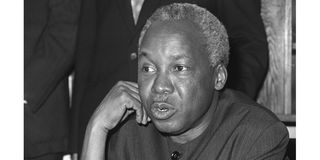Tanzania’s refugee burden and Nyerere’s mediation role highlighted in CIA files

Tanzania's first President Julius Nyerere. FILE
What you need to know:
- The records paint a picture of a nation balancing compassion, diplomacy, and national security in a time of unprecedented regional upheaval.
Dar es Salaam. Tanzania played a complex and pivotal role during the turbulent 1990s in the Great Lakes region—simultaneously serving as a humanitarian haven for hundreds of thousands of refugees and as a neutral mediator in some of the region’s deadliest conflicts, declassified CIA documents reveal.
The records paint a picture of a nation balancing compassion, diplomacy, and national security in a time of unprecedented regional upheaval.
The documents, recently made available through the CIA’s FOIA Electronic Reading Room, chronicle Tanzania’s challenges and strategies in dealing with mass refugee influxes from Rwanda, Burundi, and the Democratic Republic of Congo (Zaire) following genocidal violence and civil wars.
They also spotlight the diplomatic legacy of former President Julius Nyerere, who came out of retirement to lead peace efforts in Burundi.
Humanitarian frontline under pressure
Tanzania’s open-door policy in the wake of the 1994 Rwandan genocide and Burundi’s civil conflict drew praise internationally but placed considerable strain on its economy and security apparatus.
By 1995, more than 800,000 refugees were living in camps such as Benaco and Lukole near the Tanzanian border. A CIA field report from October 1994 observed:
“Tanzanian authorities struggle to manage influxes exceeding 250,000 Rwandan Hutu refugees in weeks... Resources are stretched, raising risks of disease and social unrest.”
While Tanzania earned global respect for its humanitarian stance, the sheer scale of the refugee presence raised serious challenges.
Intelligence briefings warned that some camps were becoming militarized, with reports of rebel groups—particularly Burundian Hutu militants—using the camps to regroup and rearm.
A 1996 National Intelligence Estimate cautioned: “Burundian Hutu rebels are exploiting Tanzanian camps to regroup and rearm. Tanzanian security forces lack capacity to monitor these activities, increasing potential for cross-border raids.”
Another CIA economic brief from 1997 noted that hosting refugees placed unsustainable pressure on Tanzania’s economy, particularly as international donor support began to wane.
Nyerere’s final chapter: Mediator in Burundi
Though retired from active politics since 1985, Julius Nyerere remained an influential voice on African peace and unity.
Declassified cables and memoranda reveal that U.S. intelligence viewed his mediation efforts—particularly in Burundi—as well-intentioned but fraught with complications.
Nyerere began brokering peace talks in Burundi in 1996, advocating for inclusive dialogue between the government and Hutu rebels. His efforts drew both praise and criticism.
A 1997 Presidential Daily Brief stated: “Nyerere’s insistence on including Hutu rebels in talks has angered Tutsi elites. His approach risks prolonging violence if a power-sharing agreement isn’t reached.”
Despite the obstacles, Nyerere laid the foundation for the Arusha Peace and Reconciliation Agreement, signed in 2000 after his death in 1999.
A 1998 CIA memorandum acknowledged:“Nyerere’s persistence kept international attention on Burundi, but deep ethnic divisions and competing foreign agendas (e.g., Uganda, Libya) undermine prospects for lasting peace.”
In public speeches, Nyerere also condemned Western powers for their failure to intervene during the Rwandan genocide, with one 1995 State Department cable quoting him as saying:
“Global indifference to African crises is appalling. Western powers prioritise Balkan conflicts over African lives.”
A fragile balance
While Tanzania was widely praised for hosting refugees and promoting peace, U.S. analysts were concerned about regional destabilization and the potential for violence to spill into Tanzanian territory.
A 1996 intelligence memo warned: “Hutu extremists in Tanzanian camps are recruiting youth and coordinating with Congolese rebels. Tanzania’s lax border controls facilitate arms trafficking into Eastern Congo.”
The long-term consequences were also apparent in the CIA’s internal assessments. A 1998 field report noted rising ethnic tensions between refugees and host communities, especially in northwestern regions:
“Anti-refugee sentiment is growing in northwestern Tanzania. Ethnic tensions between locals and Burundian refugees risk sparking violence, complicating Dar es Salaam’s neutrality.”
After Nyerere’s death, a 2000 CIA review expressed concern over the vacuum in regional diplomacy:
“Nyerere’s death removes a critical mediator. Without his stature, regional actors may exploit power vacuums, escalating violence in Burundi and Congo.”
What the CIA missed
Some scholars argue that while CIA documents offer valuable insights, they often missed key contextual elements of Tanzania’s approach to the regional conflicts.
Historian Priya Lal in African Socialism in Postcolonial Tanzania critiques the security-heavy framing of refugee issues, writing:
“The CIA reduced Tanzania’s refugee policy to a security threat, ignoring its roots in pan-African solidarity.”
Similarly, Paul Bjerk in his book Building a Peaceful Nation, emphasizes that Nyerere’s peace efforts were shaped by his socialist ideals:
“Nyerere’s mediation was rooted in Ujamaa’s ethos of collective responsibility—a nuance lost in Cold War-era intelligence frameworks.”
The CIA’s declassified documents offer a revealing glimpse into how Tanzania navigated one of the most volatile chapters in Africa’s modern history.
Caught between moral imperatives, diplomatic ambition, and geopolitical realities, the country emerged as both a beacon of hope and a flashpoint of risk.
As conflicts continue in parts of the Great Lakes region, the legacy of Tanzania’s 1990s diplomacy—especially under Nyerere’s guidance—remains deeply relevant.




